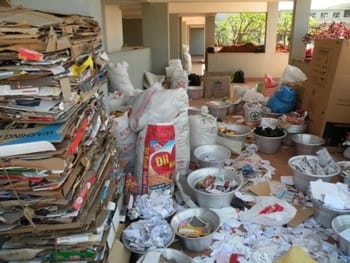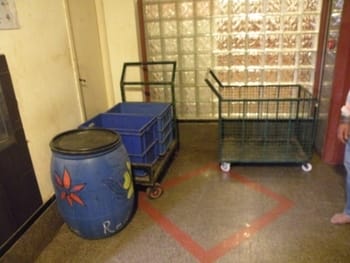p>In a series on environment-friendly initiatives, Citizen Matters introduces you to individuals and communities who are working hard to encourage sensible disposal of garbage.
The first of the series takes you through the gates of an apartment complex in the southern part of the city, in JP Nagar. One block, Mayflower, in Brigade Millenium, hit upon the idea way back in 2008, to do something about the waste that was being generated. The drive, however, didn’t convince all the residents. Only 30 out of 220 households are currently segregating their waste, while remaining still depend entirely on the BBMP garbage trucks.

Segregation of dry waste. Pic: Mayank Rungta.
Here’s what happened at Mayflower.
Mayflower block has 250 flats across 15 floors and is provided with the chute facility for garbage disposal. In fact, like most other apartments these days, the chute is considered an amenity. The block has one chute opening on every floor to take anything that a resident wants to get rid of. The garbage cleared from the chute room is then taken by a private contractor.
The idea of addressing waste management came up in 2008 as a few members of the residents’ committee found that they were disposing considerable amount of reusable-recyclable material in the garbage truck.
While the garbage collectors themselves sorted the garbage and resold some of it, residents felt it made better sense not to throw mixed waste down the chute. One member drew up a plan to separate dry waste and gave it to the committee for approval.
In Mayflower Block, around 20-30% of dry waste still gets mixed with wet waste. This is because there is a general opinion among residents that the chute is the most innovative method of waste disposal and a facility that they paid for, when they bought the apartment.
Those who feel that segregation is painful, don’t do it at all – everything goes down the chute.
Therein started the ‘Blue Drum Dry Waste Campaign’ in November 2008. The Mayflower Owners’ Association placed blue drums on every floor, near the garbage chute. Residents were requested to sort their garbage at home into wet (mainly kitchen waste) and dry waste. An initial house-to-house drive was followed by training for domestic help, housekeeping and security staff to ensure this segregation at source.
The blue drums now collect dry waste (paper, plastic, cardboard, glass, metal,) from the homes. They are cleared by housekeeping staff everyday and the dry waste undergoes secondary and further segregation in the basement area.
When it is sufficiently aggregated, it is sold to recyclers and the money is transferred to a fund meant for staff welfare.
However, since the usage of the blue drum is voluntary and is not being stringently enforced , large volumes of dry waste articles still go down the chute.
For electronic waste (bulbs, CDs, batteries, etc) separate containers are placed in a centralised location to aggregate and give to local e-waste recyclers.

Many residents feel that the chute is convenient but it actually causes a problem when it comes to waste management. Pic: Mayank Rungta.
The association also initiated a drive to reduce the use of disposable plastic/paper bags and other items:
- Steel plates and glasses were purchased by the association for common parties
- Posters explaining the ill-effects of using plastic/paper bags/other disposables and encouraging residents to use cloth bags were put up at various points in the block.
- Posters were also put up at a few neighbourhood shops indicating the number of plastic bags used by them on a monthly/yearly basis. This resulted in some of the shops offering customers a discount for bringing their own bag (which is found to have subsequently increased!).
Wet waste handling
After the Blue Drum Dry Waste programme reached a certain stability, the residents decided to address the issue of kitchen waste disposal. Some of them were already using a portion of the terrace to compost wet waste.
These residents felt that if wet waste was also handled within the building, not only would this reduce the need for the garbage truck; it would also eliminate the use of black plastic garbage bags.

The Mayflower Block started the Blue Drum Dry Waste programme. Pic: Mayank Rungta.
In October 2009, the committee approved composting on the terrace on a pilot basis for a few households. This was to assess the proposed methodology and estimate its scalability (to handle the full capacity of 250 flats) and long-term feasibility.
Based on their experience, the voluntary group feels there should be a legislation by the BBMP that makes it mandatory for apartments to segregate and manage waste within their premises – whether using ground space or terrace (depending on the building plan). Localisation of waste handling/ sorting centres is essential.
Similarly, as a rule, chutes for garbage disposal should not be sanctioned in buildings. This defeats the very goal of garbage segregation and management at source.
In layouts, some area should be earmarked for waste management, just as area is earmarked for parks and playgrounds.
Two residents volunteered to explore the pros and cons of various composting options, with the help and guidance of C. Srinivasan from Vellore (a member of the Supreme Court committee on Solid Waste Management who has done extensive work in Vellore on zero waste management). They settled upon a method that required only natural resources – manpower, air, water, sunlight and naturally occurring bacteria found in cow dung or butter milk. They also figured that in their block with limited ground space, the terrace was the ideal location – as it had ample space sheltered from rain and direct sun, with lots of natural aeration. Moreover, it was away from the homes and being on the 15th floor, any possible odour or presence of fruit flies would be minimal. The team also identified a cattle-shed nearby where the cattle-edible waste could be given, thereby minimising the infrastructure needed for composting.
Subsequent research, with the help of Srinivasan, led to the team designing a portable metal composting trolley (that could fit in the service elevator) for the pilot exercise.
The pilot was started in January 2010 – about 500 kg of wet waste was successfully composted in about 60 days.
Based on this success, it was concluded that the designed trolley could handle the full capacity of the block. So the process and its impact was then shared with residents at a meeting and orientation-cum-interaction with Srinivasan in March 2010.

At a residents’ meeting, some of them raised concerns about the waste management initiative. Pic: Mayank Rungta.
However, the residents raised a variety of objections and questions that included:
– the harmful effects of composting
– the fear of smell and disease-causing insects
– the use of the terrace (common area) for this purpose
– the closure of the chute
– the handling/carrying of waste on the stairs and in the lifts
– unwillingness to put in the effort to segregate at home
– the need to do it at all – when it was not mandatory by the BBMP!
It was not easy and as one of the volunteers from an external group present at this meeting remarks, “I never knew educating the educated could be so tough”.
Some residents unconvinced
Despite a lot of explanation and reassurances on the safe and non-hazardous nature of composting, residents remained unconvinced. Some even went to the extent of saying that Bangalore’s waste situation was not so bad as to expect them to handle their own waste! As a result the pilot exercise had to be shelved. Not just that other residents did not cooperate, they were unwilling to let even those interested continue, as it involved using common areas and facilities.
Currently, a group of voluntary households (presently about 30) sort their wet waste into cattle-edible and non-edible. The edible items are collected door-to-door at about noon everyday by the housekeeping staff.
The wet waste is is delivered to the cattle shed nearby.
This group hopes that other households also begin to sort their waste like this and ultimately the chute can be closed – to ensure segregation at source.
Their advice
-
- Any large waste management drive is bound to attract oppositions from one section of the residents. Consensus building in such an environment is a slow and tough process. Therefore it is best to start small and and expand it in phases, while simultaneously educating and spreading awareness among residents

Some residents continue to segregate waste voluntarily. Pic: Mayank Rungta.
- There are lots of misconceptions about composting. Even people who ‘understand’ the problems of waste are often not ready to have composting anywhere near their residence! It is therefore very important to make people understand that having a composter in their neighbourhood is not a health hazard and is the only solution for growing garbage issues. On the contrary, not having it and disposing mixed waste at the landfill or elsewhere is a bigger health risk!
The example of Mayflower Block at Brigade Millennium is just one. Their endeavour to kick-start a waste management system may not have worked effectively, but the team is still hoping to ‘convert’ the other residents as well. Do you have a similar story to share? What is your take away from the Mayflower experience? How would you handle such a situation at your apartment complex? Share your experience with us.
⊕
Excellent article. It shows us all that the real enemy to growth and development may not be BBMP’s incompetence, but our so-called “sophisticated and educated” citizens. I say, Brigade Mayflower folks boycott the rest of the families who are laggards in this great effort. More articles like this please.
I think this is a problem everywhere – if well educated people are not aware of the impending problems, how do you expect others to worry about this problem ? Fundamental to this issue is the centralized big city development which encourages this throw away mentality – it is the city’s problem not mine. So as long as this mad rush towards urbanization continues, the situation is only going to get worse. BTW, personally I don’t throw out any wet waste anymore, I compost it and use it. If you are frustrated in getting support, do it on your own with dailydump’s products.
Hi Vinita, can you please share the contacts of the key people behind this excellent drive at Mayflower? I live in an apt at Brookefields and would like to start a similar drive here. Any practical insights from the team will help..
Thanks, Minal
Hi Minal,
Good to know that you are about to start this good initiative.
You could contact us at vidyagomathi [a] gmail.com or arathimy [a] gmail.com
Would be glad to help.